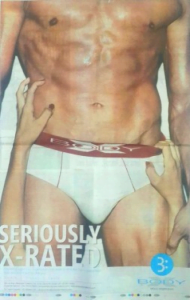Buying underwear can be tricky business. Only yesterday, I was at the departmental store to get some for the next few months. Unfortunately, none of the stores I tried were selling combo packs at the price I usually buy them. However, it was not a surprise, as underwear for either sex carries a significant amount of ‘sex appeal’ – a commodity that is increasingly being sold for higher and higher.
Then I tried buying them cheap online. While the world isn’t new to sexism and objectification of women in the world of advertising, this pack in the picture below seemed too offensive to miss. I had seen the obnoxious lipstick marks branding on this company’s briefs before, but that was before I had realised the significance of the objectification and the sexualization of random everyday products. I clicked and then the product description appeared.
“Keeps you comfortable. Makes women drool.”

It is the basic function of a pair of briefs to keep one comfortable. That’s what I have always wanted mine to do. Alongside that function in the product description, it is mentioned that the pair makes women ‘drool’. “Women” refers to one entire half of humanity. The ad tells you that making one half of humanity drool is as easy as just being comfortable, and both can be achieved with just one pair of briefs.
Wearing this pair of briefs apparently keeps the wearer comfortable and makes the opposite sex drool, regardless of what they (the women) desire. Saying two entirely different things in the same breath also makes the latter (women drooling) as normal and acceptable as the former (feeling comfortable), doing away with the very concept of female choice and consent and laying the ground for female objectification.
But come to think of it, even to make one woman drool, let alone half of humanity, the wearer will have to take his pants off. Do said women even want the wearer to take his pants off? Secondly, the word ‘women’ indiscriminately refers to just about any female. The wearer of the underwear is individually, and directly addressed, while an entire gender group is taken for granted.
But how did women even come to be related to men’s underwear? When did lipstick marks, suggestive of female desire, start appearing on the second skin of a man’s body?
Women (or their mouths) are represented as existing purely for male pleasure.
Wikipedia reveals that briefs are modern day, athletic underwear that help to keep the wearer’s genitals in place. The relation of athleticism to sexual performance could, momentarily, pass off as a reason why women are made to enter the discourse of male underwear. The conspicuous presence of lip marks everywhere in a specific underwear brand’s ads is problematic as it is.

Words and images like “drool” and lipstick prints drive home pervasive images — the female mouth and the male genital — without your even knowing it. Stereotypes have traditionally run the ad world, but these images are far too strong to have harmlessly used common stereotypes to drive sales. In the above image, apart from the multiple lip marks on the upper body, it is easy to notice one of the thigh. Subconsciously, these ads have you believe that the female mouth is a tool to titillate the male genital. Women (or their mouths) are represented as existing purely for male pleasure, further objectifying them. The unnecessary sexualization of male underwear drives home this point.

This cringeworthy full page ad appeared on the back page of a national daily sometime last year. The ad shows a man in white briefs, with a physique that conforms to every possible stereotype of the ‘desirable’ male body. The man is muscular, with a washboard abdomen, and a well-oiled and veiny torso. Even as he stands flaunting his abs and his briefs, two hands cling to his body – one clutching at the waistband, evidently trying to get his underwear off, the other groping lustily at the abs. The hands, evidently, are that of a woman’s, as indicated by the red nail paint and slender wrists.
What is dangerous about such ads is not just that they endorse male entitlement, but the subtle way they do it. This ad feeds off and reinforces ideas of masculinity and femininity, both with the buff male body and the delicate female hands. The muscularity of the man, of course in addition to the ‘X-rated’ brief, entitles him to get oral sex from the woman with slender arms and nail paint, who is portrayed as simply ravenous for the man. The basic functionality of the underwear – keeping the wearer comfortable – is ignored in favour of this blatant sexism.
Gaining acceptance from women is another parameter behind conceptualising, designing, and promoting men’s underwear. This is further established and reinforced by dating sites and magazines that dole out plastic advice on grooming and attractiveness and set unrealistic expectations for both men and women to follow. One shouldn’t forget that these are the same people that promote consumerism and materialism, not to forget blatant sexism. This ‘acceptance’ from women is guaranteed to men, as long as they buy certain products or follow certain instructions.
The product is the bait, a man, the predator, and the woman, the trophy.
These are the sites that say that if a woman ‘plays’ with her hair while talking to a man, or touches him (read: breathes and continues to exist), she is interested in him. These are the same knowledge banks that tell men ‘undeniably true’ rules on how to impress a woman. What is remarkable is that all of this knowledge system takes into account no individual taste or personal choice, assuming straight out that every woman is the same, and thus, one pair of briefs can impress every woman, and further, make her drool.
The same is true of deodorant ads, formal and casual menswear ads, jewelry ads, and condom ads. Most of these ads follow the same, oft-repeated structure. The product is the bait, a man, the predator, and the woman, the trophy. This is the same culture that imperceptibly circulates preposterous lies about the female sex drive, claiming to formulate a handful of tangible formulas to ‘score’ women.

The stamp of approval in the image and elsewhere above purports to create a faux regard for women’s advice in matters of personal hygiene and cleanliness, since they apparently are on the other end of the gender binary. The pretext of getting the opposite sex’s “approval” then makes a shift towards taking its agency for granted. If they approve of it, they must be willing to have oral sex with the wearer. Declaring that a pair of briefs will make women ‘drool’ is not just taking away all agency or personal choice from them, but is to openly dehumanize them. Consent doesn’t even make the picture. To put it crudely, getting sex, then becomes akin to playing fetch with a pair of briefs.
It sends the message that women are mere physical entities, full of carnal energy, and need only a trigger, in this case, underwear, to happily let their bodies be used.
Such imagery only serves to worsen the culture of male entitlement prevalent all around us. For a generation of men that already goes around flaunting underwear waistbands and shoving their virility in everyone’s face, it sends the message that women are mere physical entities, full of carnal energy, and need only a trigger, in this case, underwear, to happily let their bodies be used. Over a period of time, such assumptions get wired into the male imagination, and when the results promised by sexist advertisements are not achieved, it engenders a culture of rape and its justification, most often put as ‘she was asking for it’.
About the author(s)
Prannay doesn't get sexist jokes. He is a literature student who dabbles in experimental poetry, existentialist fiction, and black-and-white photography.




